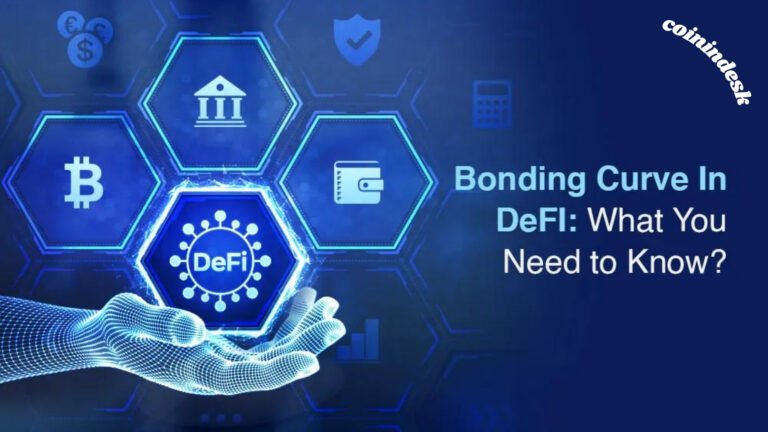Bonding Curves in DeFi: In decentralized finance (DeFi), bonding curves utilize mathematical formulas and smart contracts to dynamically adjust the price of a token based on its supply. The cost of a token is determined algorithmically by its circulating supply using bonding curves, which are smart contracts. The cost of a token increases when more are purchased and decreases when fewer are sold or removed from circulation.
Thanks to this automated pricing mechanism, there is no need for conventional order books or third-party liquidity providers. It guarantees that new tokens will have liquidity by incorporating liquidity into their smart contract. To be more precise, bonding curves use the laws of supply and demand to their advantage. An increase in purchases indicates a rise in demand for a token, and the smart contract responds by adjusting its price accordingly. Additionally, the smart contract reduces the price when selling behavior suggests a decline in demand.
This algorithmic dynamic adjustment is based on a previously specified curve that models the link between the amount delivered and pricing. Bonding curves enable automated, decentralized liquidity that responds to real-time market conditions.
Price Determination in Bonding Curves
DeFi’s bonding curves support various economic tactics and market dynamics by adjusting token pricing based on supply. Through mathematical modeling, projects can personalize bonding curve tokenomics by designing distinct curves that dictate the relationship between a token’s supply and price. While theoretically any shape might be a curve, the most common varieties include:
Linear curves
Token prices rise directly with token sales volume in a straightforward mathematical model called a linear bonding curve. Under this concept, there is a fixed, predetermined amount by which the price of each token increases as more are issued or sold.
Exponential curves
According to exponential curves, the token’s price is proportional to its supply. Therefore, the price will increase by more than 100% if the supply doubles. Prices can skyrocket with just a little increase in the number of tokens, causing the token’s value to increase substantially.
The early birds get the biggest rewards from these curves. When demand increases, the initial users will probably earn much more money from token sales. Therefore, projects that encourage early participation can benefit from exponential growth curves. When a project is successful, the initial users stand to gain the most from the risk they took.
Logarithmic curves
Initially, adding more tokens causes the price to rise sharply due to the logarithmic nature of the curve. The price gains, however, begin to level out as the supply continues to grow. Thus, there is an initial increase in price followed by a gradual leveling out. Because their tokens increase in value immediately, early investors stand to gain the most from this. The earliest buyers can offer liquidity if they see quick profits initially.
As an alternative to the more common exponential, logarithmic, and linear models, DeFi (Decentralized Finance) by Esteemcrypto allows for a wide variety of bonding curve types. Different curves can address several bonding curves regarding economic outcomes and project goals. For example, S-curves are designed for phased expansion and stabilization, Step Curves are used for milestone-based price rises, and Inverse Curves are used to cut prices as supply expands.
Bonding Curve Applications in Crypto

Bonding curves simplify projects, trading, stablecoins, communities, and governance by offering automated token liquidity and dynamic prices. In IDOs, bonding curves are the backbone of automatic liquidity bootstrapping, which lets projects release new tokens with dynamically modified reserves for the liquidity pool. Unlike conventional order books, this technique guarantees algorithmic and real-time liquidity adaptation to demand. Bonding curves make blockchain’s dynamic price flexible, enabling token trade and distribution.
For autonomous market building, platforms like Uniswap and Curve utilize bonding curves, which enhance liquidity and facilitate more efficient trading of numerous tokens, particularly those with otherwise low liquidity.
Bonding Curves in DeFi: Stablecoin systems rely heavily on bonding curves to ensure the decentralized stability of digital currencies by accumulating reserves and maintaining their peg through algorithmic supply adjustments. Nevertheless, this strategy has risks, as algorithmic stablecoins rely solely on bonding curves and programmed supply fluctuations to preserve their value stability.
For example, in May 2022, due to a severe bank run, the algorithmic stablecoin TerraUSD (UST) reserves were depleted, resulting in the coin losing its 1:1 dollar peg. This demonstrates that decentralized algorithmic stablecoins face stability issues compared to asset-backed solutions. Algorithmic stablecoins may struggle to maintain their peg in the event of a sudden decline in demand. Therefore, bonding curves permit decentralized stability measures; compared to collateralized alternatives, they have not demonstrated complete resilience to bank runs.
Continuous token models enable autonomous market development, real-time demand-based pricing, and automated liquidity bootstrapping in decentralized finance (DeFi). Bonding curves facilitate this. They help administer decentralized autonomous groups by facilitating bonding curves for voting token purchases. However, this mechanism ensures that pricing accurately reflects the level of commitment to the DAO and aligns investment with governance participation.
Decentralized Exchanges (DEXs) and Bonding Curves

Bonding curves enable customized, automated, and decentralized liquidity and pricing for various decentralized exchanges (DEXs).
Uniswap
Uniswap’s automated market maker (AMM) protocol utilizes a particular bonding curve based on a constant product formula. To ensure liquidity, this formula maintains the product of the quantities of the two assets in any specific liquidity pool at a steady level. Supply and demand will decide the price if the pool includes Ether (ETH) and another token, since their product amounts are constant. This method provides continuous liquidity and price discovery, eliminating the need for conventional order books.
Curve Finance
Stablecoins are the main focus of Curve Finance in DeFi, which uses a tailored bonding curve optimized for assets with identical values. Stablecoins reliant on the US dollar have a bonding curve to minimise slippage and ensure stable pricing. Stablecoin swaps benefit from the flatter curve, which reduces the effect of trades on price movements for assets with comparable values.
Balancer
Bonding Curves in DeFi: By employing a more flexible variation of the constant product formula, Balancer enables users to create unique liquidity pools that include up to eight assets with varying weights. Users can utilize this adaptability to create liquidity pools and self-balancing portfolios tailored to their specifications, complete with a bonding curve that specifies the correlation between the quantity and price of assets in the pool. Balancer’s method extends bonding curves beyond two-asset pools to support a wider range of trading and portfolio management strategies.
Bonding Curve Implementation Issues
Bonding curve modeling, security, and legal challenges arise when creating, deploying, and regulating automated token pricing systems. These systems require testing, auditing, and compliance analysis to ensure their effectiveness. Designing curve shapes that align incentives and stimulate market behavior requires extensive modeling and testing. Overly steep or shallow curves might affect prices.
Smart contracts implementing bonding curves should undergo security audits to maintain the integrity of prices. Improving smart contracts can help reduce the costs of automated trading gas. Bonding curve smart contracts must be effective to prevent manipulation and arbitrage. Tests, audits, and bug bounties reduce this risk. Research is underway to apply algorithmic modifications to dynamic curves in response to market conditions.
We still don’t know how to regulate bonding curves. Most governments have not clarified whether AMMs, similar to bonding curves, are regulated markets for trade or ICOs. Tokens sold through bonding curves entitle projects to specific rights, which must be examined on a country-by-country basis. Different jurisdictions have different restrictions on crypto assets and securities.
Token holders may need to comply with securities laws if they derive profits or exercise control. Other jurisdictions may classify utility tokens more leniently, even if they include profit or governance rights. Projects should analyze target market regulations. Many projects employ utility tokens. This model grants token holders access to the project’s goods and services without providing them with profit or governance rights. This limited token design often circumvents security laws. However, KYC and AML requirements may not apply to utility tokens. These laws require verification of identity and the source of funding.
FAQs
1. What is a bonding curve in DeFi?
A bonding curve is a mathematical model in a smart contract that adjusts token prices based on supply. It enables automated, decentralized price discovery without the need for order books.
2. How do bonding curves determine token prices?
Token prices increase as more tokens are bought and decrease when sold, using predefined formulas like linear, exponential, or logarithmic curves.
3. Where are bonding curves used in DeFi?
They’re used in IDOs, stablecoins, DAOs, and DEXs, such as Uniswap, Curve, and Balancer, to automate liquidity and price dynamics.
4. What are the benefits of using bonding curves?
They offer real-time pricing, automatic liquidity, and incentivize early participation without relying on third-party market makers.
5. What challenges do bonding curves face?
Security risks, regulatory uncertainty, and modeling complexity can impact the implementation and legal compliance of these initiatives across various jurisdictions.


